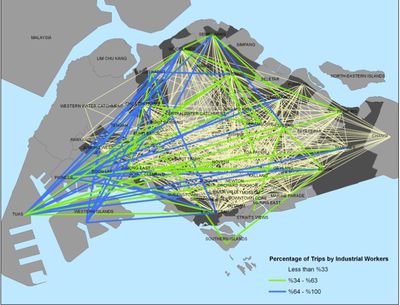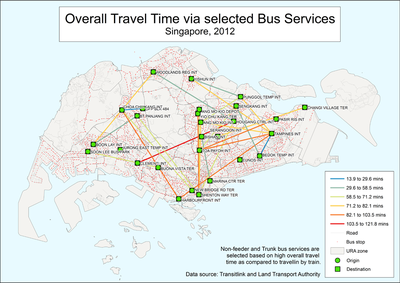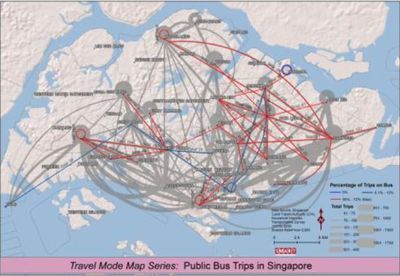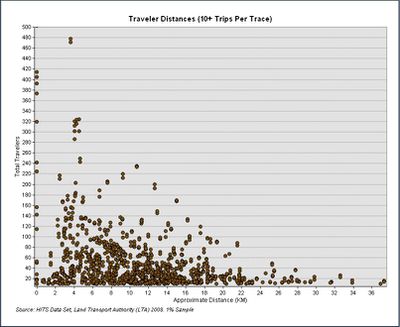Difference between revisions of "JJJ: Proposal"
| Line 35: | Line 35: | ||
|- | |- | ||
| | | | ||
| − | <p><center>''' | + | <p><center>'''Commuting Patterns of Industrial Workers''' </center></p> |
[[File:% Trips by Industrial Workers - Working Social Document.JPG|400px|center]] | [[File:% Trips by Industrial Workers - Working Social Document.JPG|400px|center]] | ||
<p><center>'''Source''': http://web.mit.edu/11.521/papers/WorkingSocialDocument_Aug2012_v2.pdf </center></p> | <p><center>'''Source''': http://web.mit.edu/11.521/papers/WorkingSocialDocument_Aug2012_v2.pdf </center></p> | ||
|| | || | ||
| − | * | + | * A static chart which is not intuitive prevents users from identifying a single path |
| − | * Colour scheme | + | * Colour scheme makes it difficult to differentiate (Green vs Yellow) |
| − | * | + | * Too many lines makes it difficult for users to identify the region names |
| + | * Brushing and filtering is needed to focus on area of concern while muting out other points to reduce clutter on visualisation | ||
|- | |- | ||
| − | | <p><center> '''An | + | | <p><center> '''An analysis of Bus Travelling Time''' </center></p> |
[[File:Bus travel time.png|400px|center]] | [[File:Bus travel time.png|400px|center]] | ||
<p><center> '''Source''': http://sgtptr.chrissng.net/ </center> </p> | <p><center> '''Source''': http://sgtptr.chrissng.net/ </center> </p> | ||
|| | || | ||
| − | * | + | * Lack of clear and uniform intervals on the legend |
| + | * Usage of decimal for values of data presented (mins of travel) is not appropriate in the context of the data. (i.e. Usuall people would round up to an integer when indicating a range) | ||
| + | * Every origin is a destination which makes it redundant to show origin and destination legends | ||
| + | * The names of the places are well labelled and clear | ||
|- | |- | ||
| <p><center> '''An Interactive Visualization to Show Trends And Events Shaping History of Terrorism''' </center></p> | | <p><center> '''An Interactive Visualization to Show Trends And Events Shaping History of Terrorism''' </center></p> | ||
Revision as of 16:37, 4 October 2016
Proposal
|
Contents
Problem & Motivation
Land scarcity is persistent issue faced by Singapore since its independence, being a country with only the size of a typical city or smaller of a fellow developed nation. As such, one of Singapore’s main challenges is in the area of Urban Planning to optimize land use without compromising on the standards of living for its residents.
One of the ways to assess the effectiveness of urban planning would be to study commuter patterns, understanding how people travel for their work and educational needs. Some who stay near to their workplace enjoy a shorter journey with less commuting time. However, there are also people who stay far from their workplaces and spend long hours on travel, for example an individual who stays at Tampines yet having to travel to Tuas for work. Hence, we would like to create a tool to gain a closer look into commuter patterns in Singapore to find out more on current commuter patterns. We believe that the tool in investigating commuter patterns would be useful for urban planners to be able to identify potential problems and patterns in the current design so as to improve the urban landscape in preparation for population growth.
Objectives:
- To explore recent commuter data for bus travel in Singapore
- To visualize commuter patterns during the morning peak hours
- To explore the impact of current commuter patterns on possible challenges in urban planning
- To create a visualization for an easy and intuitive understanding of the current situation for the average Singaporean
Background Survey of Related Work
| Related Works | What We Can Learn |
|---|---|
|
|
|
| |
| |
| |
|
References
- http://worksingapore.com/articles/live_4.php
- https://www.lta.gov.sg/content/dam/ltaweb/corp/PublicationsResearch/files/ReportNewsletter/LTMP2013Report.pdf
- https://www.quora.com/In-Singapore-it-takes-more-than-an-hour-to-reach-a-destination-via-the-public-transport-bus-train-but-just-quarter-of-the-time-if-I-were-to-take-the-taxi-Would-we-still-call-the-public-transport-successful
- http://web.mit.edu/11.521/papers/WorkingSocialDocument_Aug2012_v2.pdf
- http://www.enterpriseinnovation.net/article/singapores-transport-vision-analytics-new-interfaces-autonomous-vehicles-1298824564
- http://business.asiaone.com/career/news/3-factors-determine-if-singaporeans-leave-their-jobs
- http://community.jobscentral.com.sg/articles/your-daily-work-commute-ruining-your-life
- http://blog.moneysmart.sg/lifestyle/cheap-fast-and-painless-commuting-in-singapore-is-it-possible/
- http://lkyspp.nus.edu.sg/wp-content/uploads/2014/01/Transport-Planning-for-Singapore.pdf
- http://lkyspp.nus.edu.sg/wp-content/uploads/2013/04/Barter-Sg-urban-transport-sustainable-by-design-or-necessity.pdf
- https://www.ura.gov.sg/uol/master-plan/view-master-plan/master-plan-2014/Growth-Area
- http://www.smartnation.sg/initiatives/Mobility/spearheading-research-in-standards-for-sdvs
- https://www.ura.gov.sg/skyline/skyline09/skyline09-02/text/04.htm
Key Technical Challenges
Description of the approach (Storyboard)
Milestones
Test
Comments
Please feel free to comment on our proposal.



